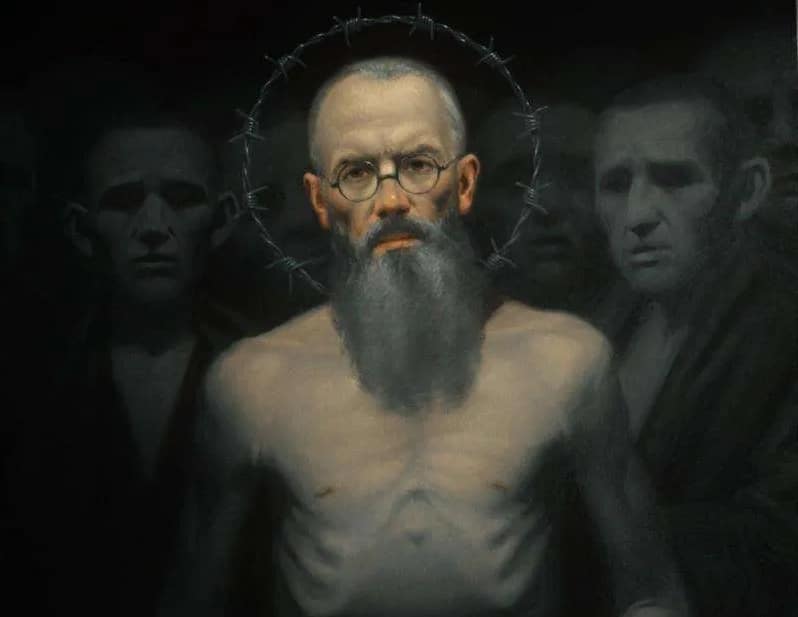Every saint’s story and life's testament still resonates today no matter how sizeable the passage of time between us and them. But the story of Saint Maximilian Kolbe, whose Feast Day is celebrated today, seems particularly relevant given current events around the world. <br><br>This includes especially the recent atrocities committed by Hamas in Israel on 7 October 2024, as well as the subsequent war in Gaza with its attendant horrors, compounded by combat in an urban environment leading to appalling numbers of civilian casualties.
His Feast Day this year is also occurring with immigration dominating politics on both sides of the Atlantic, and having played a part in the recent <a href="https://catholicherald.co.uk/taking-stock-of-the-uk-riots-catholicism-and-the-crisis-of-anglo-celtic-identity/?swcfpc=1"><mark style="background-color:rgba(0, 0, 0, 0)" class="has-inline-color has-vivid-cyan-blue-color">unrest and riots that broke out across the UK</mark></a>.
Both the suffering of the Jewish people and of refugees affected by war featured prominently in Kolbe's life, and were issues that he was willing to risk his life for and, ultimately, die for at the hands of the Nazis during World War II.
Saint Maximilian Kolbe – born Raymund Kolbe on 8 January 1894 – was a Polish Conventual Franciscan Friar.
During the German occupation of Poland, Kolbe refused to sign a document that would recognise him as a German – based on his German ancestry – and thereby give him a degree of protection, instead remaining at a monastery that helped to hide, feed and look after about 3,000 Polish refugees (of whom more than half were Jewish).<br><br>The monastery also acted as a major religious publishing centre, producing publications that were strongly critical of the Nazis.
In 1941, Kolbe was arrested by the Gestapo and eventually transferred to Auschwitz. There, amid the most horrific of settings, he continued to work as a priest and offer solace to his fellow inmates.
On 15 June 1941, he wrote to his mother, telling her not to worry about him:
"Dear Mama, At the end of the month of May I was transferred to the camp of Auschwitz. Everything is well in my regard. Be tranquil about me and about my health, because the good God is everywhere and provides for everything with love. It would be well that you do not write to me until you will have received other news from me, because I do not know how long I will stay here. Cordial greetings and kisses, affectionately, Raymund."
As a result of escape attempts made by inmates at the camp, the guards selected a random group of men to face death by starvation as a warning and deterrent against further escape attempts.
Kolbe was not chosen, but volunteered to take the place of a man who had a wife and young children.
During their period of dehydration and starvation, Kolby led prayers for the group and reportedly remained calm throughout the ordeal. Eventually, he and those who were still left alive were given lethal injections of carbolic acid.
Apparently, when the guards came to administer the poison, Kolbe raised his left arm and calmly awaited death. His remains were cremated on August 15, the same day as the Feast of the Assumption of Our Lady.
On 17 October 1971, Kolbe was beatified by Pope Paul VI, becoming the first Nazi victim to be proclaimed blessed by the Roman Catholic Church. In 1982, Pope John Paul II canonised him, also proclaiming that Kolbe should be venerated as a martyr.
The man whose place Kolbe took in Auschwitz survived the camp and attended both the beatification and canonisation ceremonies.
<strong>RELATED: <a href="https://catholicherald.co.uk/saints-upset-people-the-cause-of-world-war-ii-heroine-sybil-kathigasu/?swcfpc=1"><mark style="background-color:rgba(0, 0, 0, 0)" class="has-inline-color has-vivid-cyan-blue-color">Saints upset people: the cause of World War II heroine Sybil Kathigasu</mark></a></strong>
<em>Photo: 'Saint Maximilian Kolbe, Martyr of Charity', painted by Neilson Carlin, oil on canvas; the painting depicts Kolbe as a saint in Auschwitz with a barbed wire halo; screenshot from <a href="https://christian.art/daily-gospel-reading/matthew-18-15-20-2024/"><mark style="background-color:rgba(0, 0, 0, 0)" class="has-inline-color has-vivid-cyan-blue-color">www.christian.art</mark></a>.</em>



